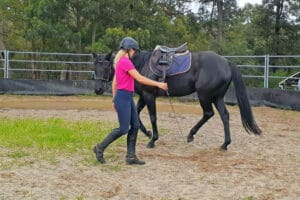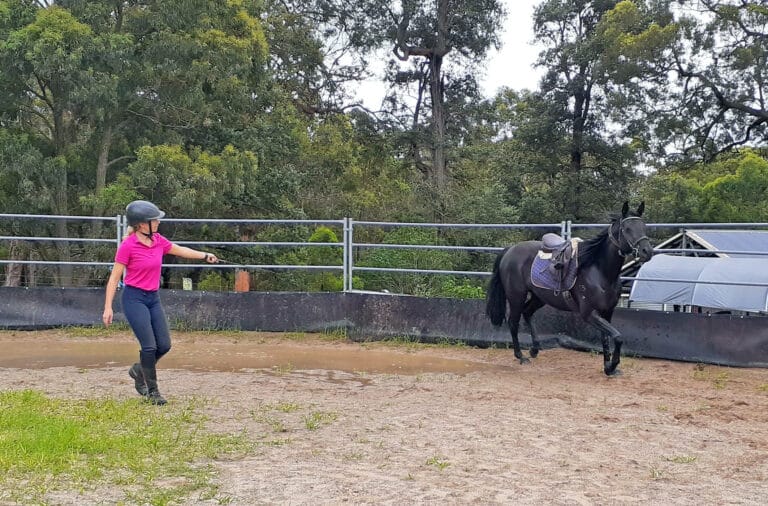Joining up with your horse is beneficial on many levels. It’s a great way to build relationship and rapport with a new horse or youngster, writes CHRISTINE ARMISHAW.
Join-up provides a window into your horse’s personality, offering insight into the way he’s likely to respond to training. It allows you to focus on the way your horse is speaking to you and the influence you have on him, based on where you position your body, how you move, and even where you direct your gaze.
In a herd situation, being in the group is safer than being on the outside. If a horse has been socially disruptive, another more dominant horse may drive them to the outer limits of the group – not great if there’s genuine threat of predators about. After a time, the ousted horse will show through body language that it now accepts the dominant horse’s authority and will ‘ask’ to be allowed back in the herd. This is the concept we are borrowing during the process of human and horse join-up.
How it’s done
In a round yard with good footing, carrying a long whip or carrot stick to use as an extension of your arm, lead your horse to the outer edge of the yard. Then, backing away slightly, use your arm extension tool to point at or flick towards the horse’s rump, coupled with verbal encouragement to walk on. Staying in walk to start with is great, but if he breaks into a trot that’s also fine.
Station yourself roughly in the middle of the yard. To keep your horse moving, stay positioned slightly behind the girth area and hunt him away with your eyes. Work the horse up and down through the paces, primarily in trot and canter. This is hard for the horse and the more intense the work is on the outside of the ‘group’, the more he’s going to want to be allowed back in.
Change direction every couple of laps and do lots of transitions. To change direction, put your whip into your other hand and move towards the outer edge of the round yard a little ahead of your horse, simultaneously raising your arms and becoming ‘bigger’ with your body and presence. Sometimes, simply positioning yourself ahead of the horse’s shoulder is enough to turn him.
Join-up takes roughly ten to twenty minutes, but can differ between individuals. All the while you are watching for signs your horse is ready to come back into the ‘herd’, specifically a lowering of the head and neck, fixing the inside ear on you, and licking and chewing. Once you notice these signs, ideally all three, join-up is likely to occur.

When he meets you in the middle, give him a rub between the eyes and the side of the neck.
Stop driving the horse forward and put the arm extender down. Avert your eyes, turn side-on to your horse and crouch a little to make your body appear smaller. Even closing your fingers together has an impact on the energy you are directing to the horse.
Now wait until he’s stopped trotting and decides to walk up to you. If he stands staring at you but doesn’t move, take a step away from him. This is often just enough to get him to walk over to you. However, if he takes the opportunity to call out to his friends or start grazing, pick up where you left off and drive him forward until you once again see the tell-tale signs, ideally more strongly, that he wants to join-up. Really make him work with loads of transitions in the meantime.
When he does come to meet you in the middle, give him a rub between the eyes and the side of the neck. Then, without hurrying, begin to walk away. Join-up is complete when your horse follows you. You can walk, stop, turn, walk, and sometimes even jog with your horse now pleasantly shadowing your movements. It is such an awesome feeling when you are at this stage! It really feels like your relationship has levelled up.

When you can walk, stop, turn, and even jog and your horse follows you, join-up is complete.
Not just for the newbies
Join-up doesn’t have to be reserved for when you first meet your horse or as part of the starting process. I like to play with my long time horses through join-up every few months or so, just to mix up the routine and reaffirm the bond we have. It’s worth pointing out that not all horses will respond in the same way. My Thoroughbred gelding joins up stunningly, and the feeling of togetherness we have immediately afterwards is the best!
On the other hand, my strong, independent and somewhat hungry Sportaloosa mare will complete the whole process nicely, but at the completion of joining she is not really so interested in staying as closely bonded to me, especially if there are a few tempting blades of grass to be eaten. But in any case, the connection between us still strengthens and the enjoyment of paying close attention to her subtle, but effervescently present equine communication always makes join-up a rewarding experience.
Drop into our VIP area to see more training videos from Christine
Feature Image: Using your arm extension tool stay positioned slightly behind the girth area and hunt him away with your eyes.



